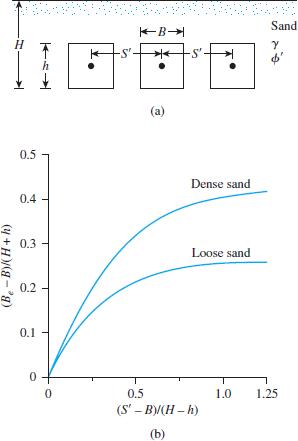Question
In Figure 1, for the anchor slab in sand, H = 1.52 m, h = 0.91 m, B = 1.22 m, S = 2.13 m,
In Figure 1, for the anchor slab in sand, H = 1.52 m, h = 0.91 m, B = 1.22 m, S′ = 2.13 m, ϕ′ = 30°, and γ = 17.3 kN/m3. The anchor plates are made of concrete and have a thickness of 76 mm. Using Ovesen and Stromann’s method, calculate the ultimate holding capacity of each anchor. Take γconcrete = 23.58 kN/m3.
Figure 1 (a) Actual case for row of anchors; (b) variation of (Be − B)/(H + h) with (S′ − B)/(H + h) (Based on Ovesen and Stromann, 1972)

(Be-B)/(H+h) H 0.5 0.4 0.3 0.2 0.1 0 h 0 K -S B * (a) -S'. Dense sand Loose sand 0.5 (S' - B)/(H-h) (b) Sand Y 1.0 1.25
Step by Step Solution
There are 3 Steps involved in it
Step: 1

Get Instant Access to Expert-Tailored Solutions
See step-by-step solutions with expert insights and AI powered tools for academic success
Step: 2

Step: 3

Ace Your Homework with AI
Get the answers you need in no time with our AI-driven, step-by-step assistance
Get StartedRecommended Textbook for
Vector Mechanics for Engineers Statics and Dynamics
Authors: Ferdinand Beer, E. Russell Johnston, Jr., Elliot Eisenberg, William Clausen, David Mazurek, Phillip Cornwell
8th Edition
73212229, 978-0073212227
Students also viewed these Civil Engineering questions
Question
Answered: 1 week ago
Question
Answered: 1 week ago
Question
Answered: 1 week ago
Question
Answered: 1 week ago
Question
Answered: 1 week ago
Question
Answered: 1 week ago
Question
Answered: 1 week ago
Question
Answered: 1 week ago
Question
Answered: 1 week ago
Question
Answered: 1 week ago
Question
Answered: 1 week ago
Question
Answered: 1 week ago
Question
Answered: 1 week ago
Question
Answered: 1 week ago
Question
Answered: 1 week ago
Question
Answered: 1 week ago
Question
Answered: 1 week ago
Question
Answered: 1 week ago
Question
Answered: 1 week ago
Question
Answered: 1 week ago
Question
Answered: 1 week ago
Question
Answered: 1 week ago
View Answer in SolutionInn App



